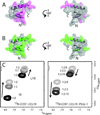Solution Structure of CCL19 and Identification of Overlapping CCR7 and PSGL-1 Binding Sites
- PMID: 26115234
- PMCID: PMC4809050
- DOI: 10.1021/acs.biochem.5b00560
Solution Structure of CCL19 and Identification of Overlapping CCR7 and PSGL-1 Binding Sites
Abstract
CCL19 and CCL21 are chemokines involved in the trafficking of immune cells, particularly within the lymphatic system, through activation of CCR7. Concurrent expression of PSGL-1 and CCR7 in naive T-cells enhances recruitment of these cells to secondary lymphoid organs by CCL19 and CCL21. Here the solution structure of CCL19 is reported. It contains a canonical chemokine domain. Chemical shift mapping shows the N-termini of PSGL-1 and CCR7 have overlapping binding sites for CCL19 and binding is competitive. Implications for the mechanism of PSGL-1's enhancement of resting T-cell recruitment are discussed.
Figures


References
-
- Fernandez EJ, Lolis E. Structure, function, and inhibition of chemokines. Annu. Rev. Pharmacol. Toxicol. 2002;42:469–499. - PubMed
-
- Forster R, Davalos-Misslitz AC, Rot A. CCR7 and its ligands: balancing immunity and tolerance. Nat. Rev. Immunol. 2008;8:362–371. - PubMed
-
- Muller A, Homey B, Soto H, Ge N, Catron D, Buchanan ME, McClanahan T, Murphy E, Yuan W, Wagner SN, Barrera JL, Mohar A, Verastegui E, Zlotnik A. Involvement of chemokine receptors in breast cancer metastasis. Nature. 2001;410:50–56. - PubMed
-
- Legler DF, Uetz-von Allmen E, Hauser MA. CCR7: roles in cancer cell dissemination, migration and metastasis formation. Int. J. Biochem. Cell Biol. 2014;54:78–82. - PubMed
-
- Weber M, Hauschild R, Schwarz J, Moussion C, de Vries I, Legler DF, Luther SA, Bollenbach T, Sixt M. Interstitial dendritic cell guidance by haptotactic chemokine gradients. Science. 2013;339:328–332. - PubMed
Publication types
MeSH terms
Substances
Associated data
- Actions
Grants and funding
LinkOut - more resources
Full Text Sources
Other Literature Sources

